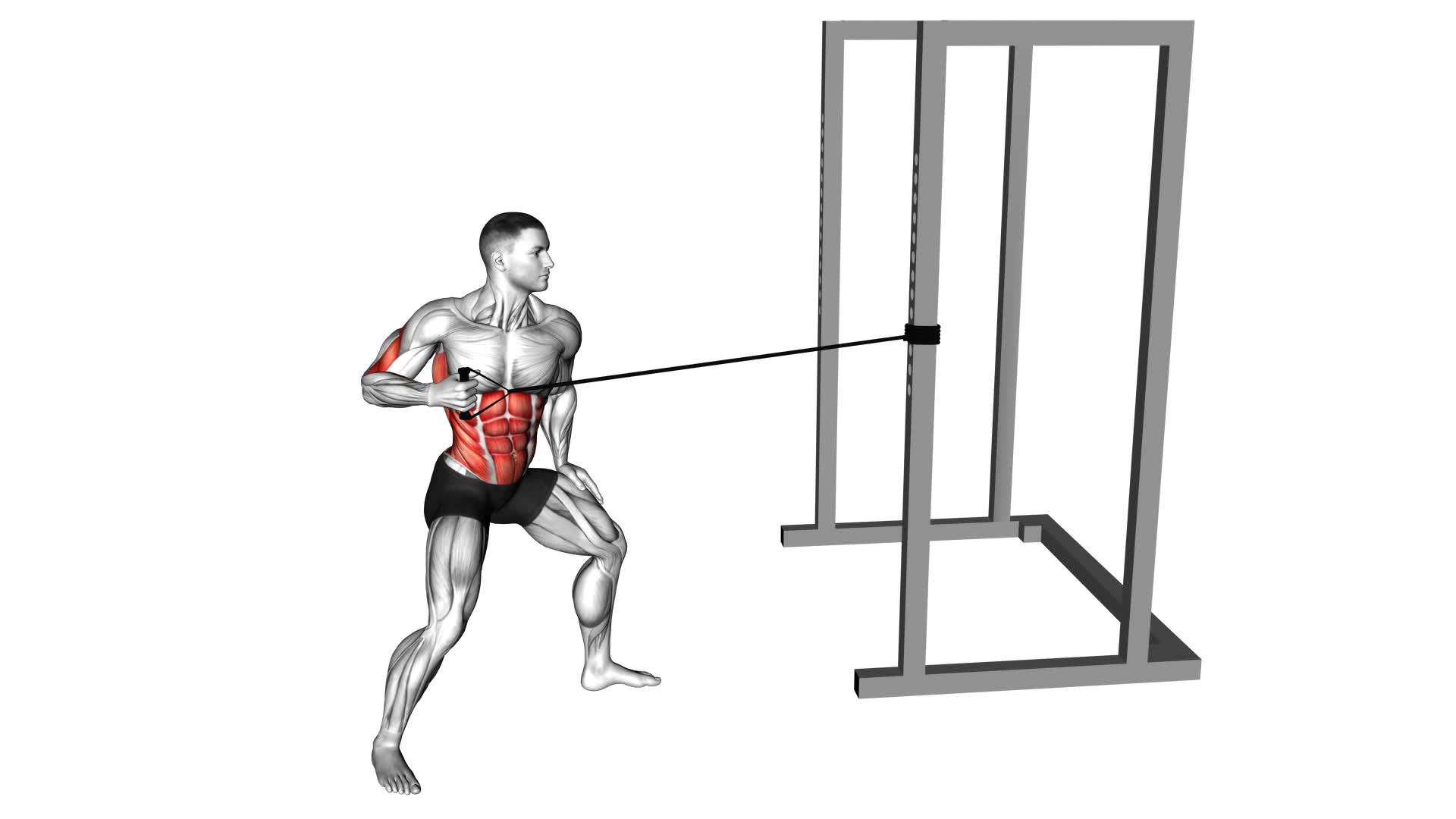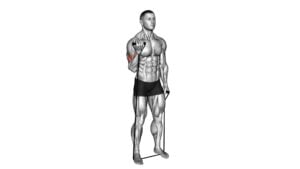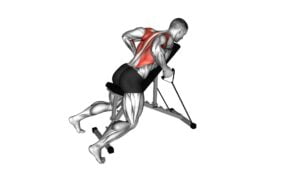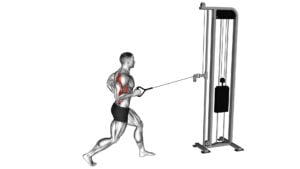Band Standing Single Arm Twist Row – Video Exercise Guide & Tips

Get ready to amp up your workout routine with the Band Standing Single Arm Twist Row. This exercise targets your back muscles while also engaging your core and improving your balance.
Watch This Exercise Video
All you need is a resistance band to get started. Watch the video guide for proper form and technique, and discover variations and progressions to challenge yourself.
Maximize your results and avoid common mistakes with these expert tips. Let's get twisting and take your fitness to the next level.
Key Takeaways
- The Band Standing Single Arm Twist Row targets back muscles, core, and improves balance.
- Engaging the latissimus dorsi and rhomboids through this exercise can lead to better posture and upper body strength.
- The twisting motion of the exercise activates the obliques, resulting in a strong and stable midsection.
- Compared to traditional rows, this exercise increases muscle activation, making it more effective for strength training.
Benefits of the Band Standing Single Arm Twist Row
To maximize your workout, discover the benefits of the Band Standing Single Arm Twist Row. This exercise is a great addition to your routine as it targets multiple muscle groups while also offering a unique twist motion.
The Band Standing Single Arm Twist Row primarily works your back muscles, including the latissimus dorsi and rhomboids, helping to improve posture and strengthen the upper body. Additionally, the twisting motion engages your core muscles, specifically the obliques, which can aid in developing a strong and stable midsection.
One of the key benefits of this exercise is the potential for increased muscle activation compared to traditional rows. The use of resistance bands adds an element of instability, requiring more effort from your muscles to maintain control and stability throughout the movement. This can lead to improved muscle strength and development.
However, it's important to be aware of potential risks when performing the Band Standing Single Arm Twist Row. As with any exercise, using improper form or too much resistance can increase the risk of injury. It's crucial to maintain proper posture, engage your core, and use a weight that allows you to perform the exercise with control and without straining your muscles or joints.
Now that you understand the benefits and potential risks of the Band Standing Single Arm Twist Row, let's move on to the equipment needed for this exercise.
Equipment Needed for the Exercise
To perform the Band Standing Single Arm Twist Row, you'll need a resistance band. Here are some different band options for the exercise:
- Light resistance band: This band is suitable for beginners or individuals with limited strength. It offers less resistance, making it easier to perform the exercise with proper form.
- Medium resistance band: This band provides moderate resistance and is suitable for individuals with some strength and experience. It allows for a more challenging workout, targeting the muscles effectively.
- Heavy resistance band: This band offers the highest level of resistance, making it ideal for advanced users or individuals with significant strength. It provides a more intense workout, helping to build strength and muscle definition.
If you don't have access to a resistance band, there are alternative exercises you can do to target the same muscle group. Some options include:
- Dumbbell rows: Use a dumbbell in each hand and perform a rowing motion, focusing on squeezing your shoulder blades together.
- Cable rows: Utilize a cable machine with a handle attachment to perform rowing motions, targeting the same muscles as the Band Standing Single Arm Twist Row.
Remember to choose a resistance band or alternative exercise that challenges you without compromising your form.
Proper Form and Technique for the Exercise
Maintain a stable stance and engage your core throughout the Band Standing Single Arm Twist Row exercise. This exercise targets your back, shoulders, and core muscles. To perform it correctly, start by standing with your feet hip-width apart and place the band securely under your front foot. Hold the band with one hand, palm facing inwards, and extend your arm fully.
Keep your back straight and slightly bend your knees. As you row the band towards your body, twist your torso and pull your elbow back, squeezing your shoulder blades together. Return to the starting position in a controlled manner and repeat on the other side.
Now, let's address some common mistakes to avoid. First, be mindful of your posture. Ensure that you maintain a straight back and avoid rounding your shoulders. Second, avoid using momentum to perform the rowing motion. Focus on using your muscles to control the movement. Lastly, don't forget to engage your core throughout the exercise to stabilize your body and avoid unnecessary strain on your back.
If you need to modify the exercise, you can use a lighter resistance band or adjust the tension by stepping closer or farther away from the anchor point. Additionally, if standing is challenging, you can perform the exercise in a seated position. Remember, proper form and technique are crucial to maximize the effectiveness of the Band Standing Single Arm Twist Row and prevent injury.
Variations and Progressions for the Band Standing Single Arm Twist Row
As you progress with the Band Standing Single Arm Twist Row, you can incorporate variations and progressions to challenge your muscles even further. Here are some modifications and progressions you can try:
- Increase resistance: If the band you're using feels too easy, try using a thicker or stronger band to increase the resistance. This will make the exercise more challenging and help you build more strength in your back and core muscles.
- Single leg stance: To further engage your core and balance, try performing the exercise while standing on one leg. This will require more stability and increase the difficulty of the exercise.
- Plyometric variation: Once you have mastered the basic movement, you can add an explosive element to the exercise by incorporating a jump or hop into the row. This won't only challenge your muscles but also enhance your power and coordination.
Remember to always maintain proper form and technique throughout these progressions. Start with lighter resistance or modifications and gradually increase the difficulty as you get stronger.
Tips to Maximize Results and Avoid Common Mistakes
To maximize your results and avoid common mistakes, focus on proper form and technique while performing the Band Standing Single Arm Twist Row.
One common mistake to watch out for is using momentum to complete the exercise. Instead, concentrate on controlled movements throughout the entire range of motion. This will ensure that you're effectively targeting the muscles and maximizing muscle activation.
Another mistake to avoid is rounding your back during the rowing motion. Keep your spine neutral and engage your core muscles to maintain stability and prevent injury.
Additionally, it's important to use the appropriate resistance level for your fitness level. If the band is too easy, you won't challenge your muscles enough. On the other hand, if the band is too difficult, you may sacrifice proper form. Find a resistance that allows you to perform the exercise with correct technique while still feeling a challenge in your muscles.
Frequently Asked Questions
How Many Sets and Reps Should I Do for the Band Standing Single Arm Twist Row?
For the band standing single arm twist row, the optimal number of sets and reps depends on your fitness level and goals.
As a general guideline, start with 2-3 sets of 8-12 reps per arm.
Gradually increase the weight as you get stronger to challenge your muscles.
To modify the exercise, you can use a lighter resistance band or perform the movement without twisting.
Remember to always listen to your body and adjust accordingly.
Can I Perform the Band Standing Single Arm Twist Row With a Resistance Band or Do I Need a Cable Machine?
You can perform the band standing single arm twist row with a resistance band or a cable machine. Both options will provide benefits for your workout routine.
The resistance band offers convenience and portability, allowing you to perform the exercise anywhere.
On the other hand, the cable machine provides a constant tension throughout the movement.
Ultimately, it depends on your personal preference and the equipment available to you.
Is the Band Standing Single Arm Twist Row Suitable for Beginners or Is It More Advanced?
The Band Standing Single Arm Twist Row can be suitable for beginners or more advanced users. For beginners, it's important to start with a lighter resistance band and focus on mastering the proper form and technique. You can also modify the exercise by using both arms instead of just one.
Advanced users can increase the resistance or try different variations, such as using a cable machine for added challenge. Remember to always listen to your body and adjust the intensity as needed.
Can I Incorporate the Band Standing Single Arm Twist Row Into My Full-Body Workout Routine or Is It More Effective as a Standalone Exercise?
You can definitely incorporate the band standing single arm twist row into your full-body workout routine. It's a versatile exercise that targets multiple muscle groups, making it an effective addition to your routine.
However, it can also be performed as a standalone exercise if you prefer. Either way, the band standing single arm twist row is an effective way to engage your core, back, and arms while improving your overall strength and stability.
Are There Any Specific Muscle Groups That the Band Standing Single Arm Twist Row Targets?
The band standing single arm twist row is a great exercise for targeting specific muscle groups. It primarily activates the back muscles, such as the lats, rhomboids, and traps.
Additionally, it engages the biceps, shoulders, and core muscles for stability and control during the movement.
This exercise can be done with variations, like using different resistance bands or incorporating a twist at the end of the row to further challenge your muscles.
Conclusion
In conclusion, the Band Standing Single Arm Twist Row is a highly effective exercise for targeting the back muscles and improving core stability.
With the right equipment and proper form, this exercise can help strengthen and tone your upper body.
By following the variations and progressions, you can continue to challenge yourself and see even better results.
Remember to focus on maintaining good posture and avoid common mistakes to maximize the benefits of this exercise.

Author
Years ago, the spark of my life’s passion ignited in my mind the moment I stepped into the local gym for the first time. The inaugural bead of perspiration, the initial endeavor, the very first surge of endorphins, and a sense of pride that washed over me post-workout marked the beginning of my deep-seated interest in strength sports, fitness, and sports nutrition. This very curiosity blossomed rapidly into a profound fascination, propelling me to earn a Master’s degree in Physical Education from the Academy of Physical Education in Krakow, followed by a Sports Manager diploma from the Jagiellonian University. My journey of growth led me to gain more specialized qualifications, such as being a certified personal trainer with a focus on sports dietetics, a lifeguard, and an instructor for wellness and corrective gymnastics. Theoretical knowledge paired seamlessly with practical experience, reinforcing my belief that the transformation of individuals under my guidance was also a reflection of my personal growth. This belief holds true even today. Each day, I strive to push the boundaries and explore new realms. These realms gently elevate me to greater heights. The unique combination of passion for my field and the continuous quest for growth fuels my drive to break new ground.







